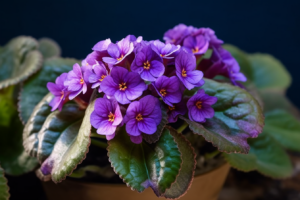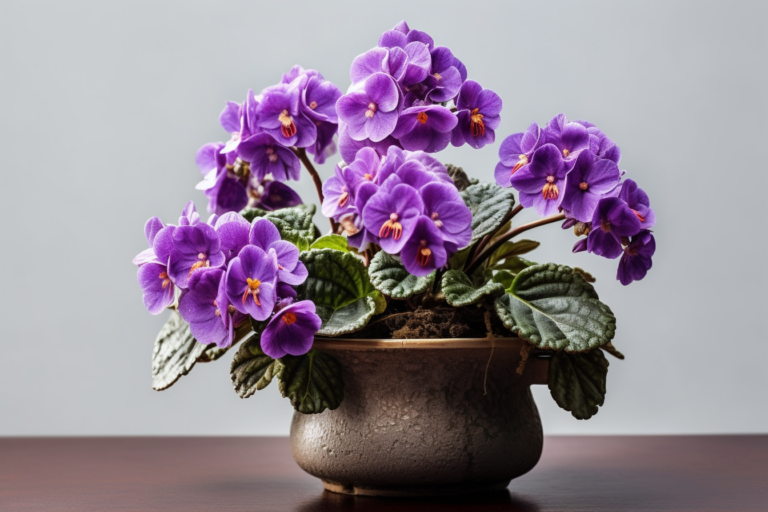African violets are some of the most popular houseplants due to their beautiful blooms and easy care. One of the most critical aspects of caring for these plants is understanding how often to water African violets. In this guide, we will explore the different factors that determine the watering frequency, how to identify signs of over-watering or under-watering, and tips for maintaining a healthy African violet.
Factors Affecting Watering Frequency
Pot Size and Material
The size and material of the pot holding your African violet can significantly impact how often it needs water. Larger pots hold more moisture, while smaller pots dry out faster. Similarly, clay pots tend to dry out more quickly than plastic pots.
Soil Composition
The type of soil used can also influence the watering frequency. African violets prefer well-draining soil, which allows excess water to escape and prevents root rot.
Humidity
The humidity level in your home can affect how often your African violet requires water. Higher humidity levels can reduce the need for frequent watering.
Light Exposure
The amount of light your African violet receives can also impact its water needs. Plants in brighter light tend to require more water than those in lower light conditions.
Temperature
Temperature plays a crucial role in determining how often to water African violets. Higher temperatures cause the soil to dry out faster, requiring more frequent watering.
Best Practices for Watering African Violets
As an African violet enthusiast, I have learned that proper watering is essential for the health and beauty of this delicate plant. Here are some best practices to follow when watering your African violets:

- Water when the topsoil feels dry – African violets prefer moist soil, but overwatering can lead to root rot. It’s essential to water only when the topsoil feels dry to the touch. Insert your finger about an inch into the soil, and if it feels dry, it’s time to water.
- Bottom watering method – While there are many methods of watering African violets, the bottom watering method is my go-to. Fill a tray with water and set the pot on top, making sure the water doesn’t touch the plant’s base. The soil will absorb the water through the drainage holes, ensuring the roots get the required moisture while reducing the risk of overwatering.
- Avoid splashing water on leaves – Water droplets on the leaves can cause damage or lead to fungus growth. When watering, try to avoid getting water on the leaves. If you accidentally do so, wipe the leaves dry with a soft cloth.
- Use room temperature water – Cold water can shock the plant’s roots, stunting growth or causing them to wither. Therefore, it’s essential to use room temperature water when watering African violets.
- Don’t fertilize when dry – Applying fertilizer to dry soil can burn and damage the plant. Always water thoroughly before using fertilizers and avoid using too much.
By following these best practices, you can maintain healthy, beautiful African violets that will brighten up any room they are in. Remember, watering and caring for plants require patience and practice, but the end result is always worth the effort.
Tools and Tricks for Watering African Violets
When it comes to watering African violets, there are a few tools and tricks that can make the process easier and more effective. Here are some tips to help you keep your African violets healthy and thriving.
Watering Can
One of the most important tools for watering African violets is a good watering can. Look for a can with a narrow spout that allows you to direct the water right where you want it. You can also choose a can with a long, narrow watering stem that allows you to reach deep into the pot.
Moisture Meter
Another useful tool is a moisture meter. This device allows you to check the moisture level in the soil, so you can be sure you’re not over- or under-watering your African violets. It’s a great investment for any serious African violet enthusiast.
Container
Choosing the right container is also important when it comes to watering African violets. Look for a pot with drainage holes in the bottom to allow excess water to escape. You can also choose a self-watering pot, which has a reservoir that keeps the soil consistently moist.
Watering Schedule
Establishing a watering schedule is key to keeping African violets healthy. Aim to water your plants about once a week, but adjust the schedule based on the temperature and humidity in your home. In hot, dry weather, your plants may need more frequent watering.
Water Quality
Finally, be sure to use high-quality water when watering your African violets. Tap water may contain chemicals like chlorine that can harm your plants. Try using purified or distilled water instead.
By following these tools and tricks, you can maintain the perfect watering routine for your African violets, keeping them healthy and beautiful for years to come.
Watering Frequency Chart for African Violets
Knowing when and how often to water African violets can be tricky. Watering frequency depends on various factors such as temperature, pot size, humidity, and soil type. In this section, I’ll provide you with a general watering frequency chart to help you keep your African violet healthy and blooming.

Watering Frequency Chart
| Condition | Watering Frequency |
|---|---|
| Dry soil | Every 3-4 days |
| Slightly moist soil | Every 4-5 days |
| Moist soil | Every 6-7 days |
Note: Keep in mind that this is a general chart and the actual watering frequency may vary based on the temperature and humidity in your home.
Identifying Over-Watering and Under-Watering
Signs of Over-Watering
- Yellowing leaves
- Wilting, even when the soil is wet
- Mold or fungus growth on the soil surface
- Root rot
Signs of Under-Watering
- Wilted or shriveled leaves
- Dry, brittle leaves
- Slow growth or lack of blooms
- Dry, compacted soil
Tips for Watering African Violets
Use Room Temperature Water
Using room temperature water can help prevent shocking the plant’s roots, which can cause stress and potential damage.
Water from the Bottom
Bottom watering, where you fill the saucer beneath the pot and allow the plant to absorb water through its drainage holes, can help prevent over-watering and encourage healthy root growth.
Avoid Wetting the Leaves
African violets are sensitive to water on their leaves, which can cause spotting and damage. When watering, try to avoid splashing water on the foliage.
Monitor Soil Moisture
Regularly check the soil moisture with your finger or a moisture meter to determine when it’s time to water your African violet.
Adjust Watering Schedule as Needed
Remember that factors like pot size, soil composition, humidity, light exposure, and temperature can affect how often your African violet needs water. Adjust your watering schedule accordingly to ensure the plant remains healthy.
Troubleshooting common watering problems
Proper watering is essential to healthy African violet growth. However, even with the best intentions, problems can arise. Here are a few common watering problems you may encounter with your African violet, and how to troubleshoot them:
Overwatering
Overwatering is one of the most common problems with African violets. Signs of overwatering include yellowing leaves, wilting, and root rot. If you suspect you’ve overwatered your African violet, take a break and let the soil dry out. You may also need to adjust your watering schedule.
Underwatering
Underwatering can cause your African violet to dry out and become weak. Signs of underwatering include droopy leaves and a dry soil surface. If you suspect underwatering, check the soil to ensure it’s moist and adjust your watering schedule accordingly.
Inconsistent watering
Inconsistent watering can cause stress on your African violet and lead to wilting, yellowing leaves, and stunted growth. To avoid this, try watering your African violet on a consistent schedule. A good rule of thumb is to water your African violet once a week.
Water quality
Water quality can also affect the health of your African violet. Tap water can contain high levels of minerals and chlorine, which can damage plants over time. Consider using filtered or distilled water for your African violet.
Improper drainage
Improper drainage can cause water to sit in the soil, leading to root rot and fungal growth. Make sure your African violet’s pot has drainage holes and use a well-draining, porous potting mix.
By troubleshooting common watering problems, you can ensure your African violet thrives and remains healthy. Remember to monitor your plant and adjust your watering schedule as needed to keep your African violet looking its best.
Other considerations for African violet care
Apart from watering, there are other important aspects to consider when it comes to African violet care. Here are some tips to help you maintain a healthy and thriving plant:
Lighting
African violets prefer bright, indirect light. Direct sunlight can burn their leaves, while too little light can inhibit flowering. If you notice your plant leaning towards the light or its leaves turning yellow, you may need to adjust its position or supplement its light with artificial sources.
Humidity
African violets thrive in a humid environment, but too much moisture can lead to mold and fungal growth. To maintain the ideal humidity level, you can place the pot on a tray filled with pebbles and water or use a humidifier.
Temperature
African violets prefer temperatures between 65-75°F (18-24°C). Avoid exposing them to extreme temperatures or drafts, as this can stress the plant and affect its growth.
Fertilization
Regular fertilization is essential for African violet growth and flowering. Use a balanced, water-soluble fertilizer every 4-6 weeks, and follow the manufacturer’s instructions for the correct dosage.
Pruning
Pruning your African violet can encourage bushier growth and more blooms. To do this, pinch off the dead flowers and yellow leaves, and trim any leggy or overgrown stems.
Potting
African violets prefer well-draining soil, and their roots are sensitive to overwatering. Choose a pot with drainage holes, and ensure that the soil is lightly moist but not waterlogged. Repotting is necessary once a year or when you notice the plant becoming root-bound.
By following these tips and paying close attention to your African violet’s needs, you can enjoy a beautiful and healthy plant for years to come.
Conclusion
Knowing how often to water African violets is essential for maintaining their health and encouraging beautiful blooms. By understanding the factors affecting watering frequency, recognizing signs of over-watering and under-watering, and following our tips, you can help your African violet thrive in your home.
FAQS
What is the ideal humidity level for African violets?
African violets prefer a humidity level of around 40-60%.
Can I use tap water to water my African violets?
You can use tap water, but it's best to let it sit for 24 hours before using it to allow any chlorine to evaporate.
How can I increase the humidity around my African violet?
You can increase humidity by placing the plant on a tray filled with pebbles and water, using a humidifier, or grouping it with other plants.
How do I know if my African violet needs to be repotted?
If your African violet is outgrowing its pot or the roots are visible at the surface or growing out of the drainage holes, it's time to repot.
Can I use a self-watering pot for my African violet?
Yes, self-watering pots can be a convenient way to maintain consistent moisture levels for your African violet, but be sure to monitor the soil to prevent over-watering.


I always struggled with watering my African Violet properly, but this guide helped me understand how often to water it. Thank you for the useful information!